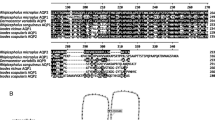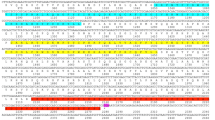Abstract
Ticks are effective vectors of pathogens because of their blood feeding and high fecundity. This high fecundity is related to the size of the blood meal. Therefore, knowledge of how blood proteins are degraded and converted to proteins, including yolk protein, is important for the development of ways to inhibit the utilization of blood proteins by ticks. RNA interference (RNAi) is becoming a powerful post-transcriptional gene silencing technique that provides insight into gene function. We constructed a double-stranded RNA (dsRNA) based on a previously cloned Haemaphysalis longicornis leucine aminopeptidase (HlLAP) gene to reevaluate the biological role in tick blood digestion. Gene specific transcriptional, translational, and functional disruptions were achieved by the introduction of dsRNA into the ticks. Significantly delayed onset of egg-laying and reduced egg oviposition resulted from the RNAi for the HlLAP gene. These results suggest that HlLAP actually works as a blood digestive enzyme and affects tick fecundity via unknown mechanisms. The reduction of egg oviposition may be caused by a decrease in nutrients, especially free amino acids generated by HlLAP, from the blood meal. This is the first report of an impact on tick reproduction caused by gene silencing of a blood digestion-related molecule.




Similar content being viewed by others
References
Agyei AD, Runham NW (1995) Studies on the morphological changes in the midguts of two ixodid tick species Boophilus microplus and Rhipicephalus appendiculatus during digestion of the blood meal. Int J Parasitol 25:55–62
Attardo GM, Hansen IA, Raikhel AS (2005) Nutritional regulation of vitellogenesis in mosquitoes: implications for anautogeny. Insect Biochem Mol Biol 35:661–675
Boldbaatar D, Sikalizyo Sikasunge C, Battsetseg B, Xuan X, Fujisaki K (2006) Molecular cloning and functional characterization of an aspartic protease from the hard tick Haemaphysalis longicornis. Insect Biochem Mol Biol 36:25–36
Bozic N, Vujcic Z (2005) Detection and quantification of leucyl aminopeptidase after native electrophoresis using leucine-p-nitroanilide. Electrophoresis 26:2476–2480
Charlier D, Kholti A, Huysveld N, Gigot D, Maes D, Thia-Toong TL, Glansdorff N (2000) Mutational analysis of Escherichia coli PepA, a multifunctional DNA-binding aminopeptidase. J Mol Biol 302:411–426
Chinzei Y, Taylor D (1990) Regulation of vitellogenesis induction by engorgement in the soft tick, Ornithodoros moubata. In: Hoshi M, Yamashita O (eds) Advances in invertebrate reproduction 5. Elsevier, Amsterdam, pp 565–570
Chinzei Y, Yano I (1985) Fat body is the site of vitellogenin synthesis in the soft tick, Ornithodoros moubata. J Comp Physiol B 155:671–678
Chinzei Y, Chino H, Takahashi K (1983) Purification and properties of vitellogenin and vitellin from a tick, Ornithodoros moubata. J Comp Physiol B 152:13–21
de la Fuente J, Almazan C, Blouin EF, Naranjo V, Kocan KM (2005) RNA interference screening in ticks for identification of protective antigens. Parasitol Res 96:137–141
de la Fuente J, Almazan C, Naranjo V, Blouin EF, Kocan KM (2006a) Synergistic effect of silencing the expression of tick protective antigens 4D8 and Rs86 in Rhipicephalus sanguineus by RNA interference. Parasitol Res 99:108–113
de la Fuente J, Almazan C, Naranjo V, Blouin EF, Meyer JM, Kocan KM (2006b) Autocidal control of ticks by silencing of a single gene by RNA interference. Biochem Biophys Res Commun 344:332–338
de la Fuente J, Almazan C, Blas-Machado U, Naranjo V, Mangold AJ, Blouin EF, Gortazar C, Kocan KM (2006c) The tick protective antigen, 4D8, is a conserved protein involved in modulation of tick blood ingestion and reproduction. Vaccine 24:4082–4095
Friesen KJ, Reuben Kaufman W (2002) Quantification of vitellogenesis and its control by 20-hydroxyecdysone in the ixodid tick, Amblyomma hebraeum. J Insect Physiol 48:773–782
Fujisaki K (1978) Development of acquired resistance precipitating antibody in rabbits experimentally infested with females of Haemaphysalis longicornis (Ixodoidea: Ixodidae). Natl Inst Anim Health Q (Tokyo) 18:27–38
Fujisaki K, Kawazu S, Kamio T (1994) The taxonomy of the bovine Theileria spp. Parasitol Today 10:31–33
Gudderra NP, Sonenshine DE, Apperson CS, Roe RM (2002) Hemolymph proteins in ticks. J Insect Physiol 48:269–278
Hansen IA, Attardo GM, Park JH, Peng Q, Raikhel AS (2004) Target of rapamycin-mediated amino acid signaling in mosquito anautogeny. Proc Natl Acad Sci USA 101:10626–10631
Hatta T, Kazama K, Miyoshi T, Umemiya R, Liao M, Inoue N, Xuan X, Tsuji N, Fujisaki K (2006) Identification and characterisation of a leucine aminopeptidase from the hard tick Haemaphysalis longicornis. Int J Parasitol 36:1123–1132
Hoogstraal H (1985) Argasid and nuttalliellid ticks as parasites and vectors. Adv Parasitol 24:135–238
James AM, Oliver JH Jr (1996) Vitellogenin concentrations in the haemolymph and ovaries of Ixodes scapularis ticks during vitellogenesis. Exp Appl Acarol 20:639–647
Joshua GW (2001) Functional analysis of leucine aminopeptidase in Caenorhabditis elegans. Mol Biochem Parasitol 113:223–232
Karim S, Miller NJ, Valenzuela J, Sauer JR, Mather TN (2005) RNAi-mediated gene silencing to assess the role of synaptobrevin and cystatin in tick blood feeding. Biochem Biophys Res Commun 334:1336–1342
Kato T, Nagatsu T, Kimura T, Sakakibara S (1978) Fluorescence assay of x-prolyl dipeptidyl-aminopeptidase activity with a new fluorogenic substrate. Biochem Med 19:351–359
Kerlin RL, Hughes S (1992) Enzymes in saliva from four parasitic arthropods. Med Vet Entomol 6:121–126
Koh K, Mori T, Shiraishi S, Uchida TA (1991) Ultrastructural changes of the midgut epithelial cells in feeding and moulting nymphs of the tick Haemaphysalis longicornis. Int J Parasitol 21:23–36
Mendiola J, Alonso M, Marquetti MC, Finlay C (1996) Boophilus microplus: multiple proteolytic activities in the midgut. Exp Parasitol 82:27–33
Miyoshi T, Tsuji N, Islam MK, Kamio T, Fujisaki K (2004) Gene silencing of a cubilin-related serine proteinase from the hard tick Haemaphysalis longicornis by RNA interference. J Vet Med Sci 66:1471–1473
O’Hagan JE (1974) Boophilus microplus: digestion of hemoglobins by the engorged female tick. Exp Parasitol 35:110–118
Oliveira MC, Oliveira-Sequeira TC, Araujo JP Jr, Amarante AF, Oliveira HN (2005) Babesia spp. infection in Boophilus microplus engorged females and eggs in Sao Paulo State, Brazil. Vet Parasitol 130:61–67
Raikhel AS, Kokoza VA, Zhu J, Martin D, Wang SF, Li C, Sun G, Ahmed A, Dittmer N, Attardo G (2002) Molecular biology of mosquito vitellogenesis: from basic studies to genetic engineering of antipathogen immunity. Insect Biochem Mol Biol 32:1275–1286
Renard G, Garcia JF, Cardoso FC, Richter MF, Sakanari JA, Ozaki LS, Termignoni C, Masuda A (2000) Cloning and functional expression of a Boophilus microplus cathepsin L-like enzyme. Insect Biochem Mol Biol 30:1017–1026
Rosell R, Coons LB (1992) The role of the fat body, midgut and ovary in vitellogenin production and vitellogenesis in the female tick, Dermacentor variabilis. Int J Parasitol 22:341–349
Sonenshine DE (1991) Biology of ticks. Oxford University Press, New York, p 303
Tarnowski BI, Coons LB (1989) Ultrastructure of the midgut and blood meal digestion in the adult tick Dermacentor variabilis. Exp Appl Acarol 6:263–289
Taylor D, Chinzei Y (2002) Vitellogenesis in ticks. In: Adiyodi KG, Adiyodi RG (series eds), Raikhel AS, Sappington TW (volume eds) Reproductive biology of invertebrates, volume XII. Recent progress in vitellogenesis. Science Publishers, Enfield, NH, USA, pp 175–199 (chapter 6)
Taylor D, Chinzei Y, Ando K (1991) Vitellogenin synthesis, processing and hormonal regulation in the tick, Ornithodoros parkeri (Acari: Argasidae). Insect Biochem 21:723–733
Zhou J, Liao M, Hatta T, Tanaka M, Xuan X, Fujisaki K (2006) Identification of a follistatin-related protein from the tick Haemaphysalis longicornis and its effect on tick oviposition. Gene 372:191–198
Acknowledgements
This work was supported by a grant from the Bio-oriented Technology Research Advancement Institution (BRAIN), Grants-in-Aid for Scientific Research (A) from the Japan Society for the Promotion of Science and a grant from the 21st Century COE program (A-1), Ministry of Education, Sports, Science, and Technology of Japan. These experiments comply with the current laws of Japan.
Author information
Authors and Affiliations
Corresponding author
Rights and permissions
About this article
Cite this article
Hatta, T., Umemiya, R., Liao, M. et al. RNA interference of cytosolic leucine aminopeptidase reduces fecundity in the hard tick, Haemaphysalis longicornis . Parasitol Res 100, 847–854 (2007). https://doi.org/10.1007/s00436-006-0336-3
Received:
Accepted:
Published:
Issue Date:
DOI: https://doi.org/10.1007/s00436-006-0336-3




